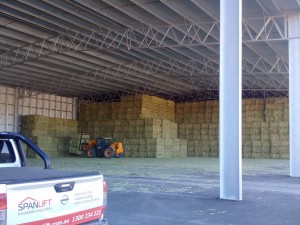This means Hay Sheds achieve payback periods of less than two years… The business case for hay sheds is strong indeed.
As Hay growers prepare to cut their paddocks for silage or hay, a generous inventory of hay remains in sheds across southeast Australia.
The days are getting longer, and according to hay growers in northern Victoria, one more September rain would be ideal to get their crops through to the maturity required for cutting.
Some dairy farmers in the Rochester area are considering cutting pasture paddocks for silage.
Pasture growth has been impressive in the sunny days of early spring. With an early cutting time, they hope they can optimise the quality by avoiding high fibre and low digestible silage typical of mature bulky pasture stands.
Livestock producers in Victoria are confident of their fodder supplies for the approaching season.
Except for East Gippsland, winter growing season rainfall for Victoria has been average to above average.
Pasture paddocks are growing well and there appears to be a healthy buffer of hay available if bought-in hay is needed next year.
The carry-over supplies of hay this season will be as high as they have been for many years.
A dairy industry just starting to recover from a lack of confidence, combined with record hay production last year has meant hay supplies have far exceeded demand.
Hay sheds, an essential component of any hay enterprise, will continue to play a valuable role in marketing production from last year to fill next year’s feed gaps.
This year has provided some of the most compelling evidence for return on investment into secure storage for hay.
Growers producing either pasture, cereal or legume hay benefit from access to shed storage by minimising the loss of quality from that achieved at baling.
As hay is so over-supplied, quality is critical in achieving a break-even price.
Cereal hay baled from the same paddock can vary in price from $50 a tonne ex-Wimmera farm if the bales are stacked in the open, to $100 a tonne if the same hay is shedded.
Hay storage is also a substantial component for supplying the export market.
Prices for export oaten hay are well ahead of the domestic prices.
Some growers have been delivering contracted oaten hay to exporters during August and achieving $180 a tonne ex- Wimmera farm.
Hay of the same quality has struggled to achieve $130 a tonne ex-farm.
To ensure the highest quality on their deferred delivery contracts, exporters have been paying a $30 a tonne price premium to compensate growers for storing hay in sheds for six months.
Hay exporters appreciate that secure storage for hay is essential for maintaining consistent quality and return business from their north Asian customers.
Premiums such as this, combined with the full tax deductibility of the capital purchase price of hay sheds within three years of purchase, mean hay sheds achieve payback periods of less than two years.
The business case for hay sheds is strong indeed.
Taken from Colin Peace, the Weekly Times



